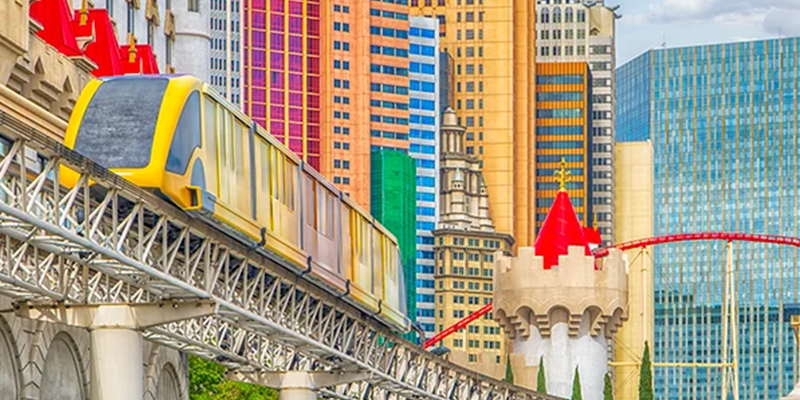The combination of “Las Vegas” and “transportation” faces long odds of appearing on many word association lists currently, but several innovative enterprises ongoing in the area may one day change that.
Attendees at NAIOP’s CRE.Converge were given the opportunity to tour some of these projects and witness firsthand how the Las Vegas metropolitan area is positioning itself to be at the forefront of how people move around locally, regionally and nationally.
Brightline West Station Site
The first stop was at the future flagship station of Brightline West, which is planned to be the nation’s first true high-speed rail service, connecting Las Vegas to Southern California. Once the system is completed, electric trains will travel 218 miles of track between Las Vegas and Rancho Cucamonga in approximately two hours – twice as fast as the normal drive time.
According to Brightline, nearly 50 million trips occur annually between Los Angeles and Las Vegas, and more than 85% involve car travel.
Brightline broke ground on the 110-acre station site, which sits between Interstate 15 and Las Vegas Boulevard and north of Blue Diamond Road, in April. In addition to building a 90,000-square-foot station, the development will involve the construction of three major roads and a 1,200-car parking garage. Officials from Brightline said they see the potential for 7 million to 9 million square feet of development around the station, likely heavier on the residential and retail side initially, but with flexibility designed in for other uses over the ensuing decade.
The Las Vegas station will be one of the first (of four total stations) to begin construction, likely early next year. Construction of the entire system is expected to take approximately four years, with service beginning toward the end of 2028. Brightline West anticipates serving more than 9 million one-way passengers annually.
Thrive Aviation
Moving on from high-speed rail, tour attendees next visited a hangar operated by Thrive Aviation, a curator of private aviation services. The company owns/operates and manages fleets of light, super-mid, large cabin and ultra-long-range aircraft.
Thrive Aviation CEO Curtis Edenfield noted that he moved the company from Dallas in 2019 in part because the most popular route in private aviation is between Los Angeles and Las Vegas. In addition to its hangars, the company built a 17,000-square-foot headquarters in nearby Henderson in 2021.
Clark County currently operates five airports, with plans to open Southern Nevada Supplemental Airport in 2037 to expand aviation capacity in the area. Harry Reid International Airport ranked as the nation’s eighth busiest by total passenger boardings for 2023. Jim Chrisley, senior director of the Clark County Department of Aviation, told tour attendees that the 2020 opening of Allegiant Stadium “changed our whole airport system.” The domed multipurpose stadium is home to the NFL’s Las Vegas Raiders and also draws huge crowds for concerts and other global events. It hosted the Super Bowl this past February, is set to host WrestleMania in April and will serve as one of the venues for the 2025 Concacaf Gold Cup.
Dan Laliberte, vice president of The Ribeiro Companies, noted that the sizes of the private aircraft flying to Las Vegas have increased since Allegiant Stadium opened, which also means there is a need for larger hangars. The Ribeiro Companies is in the process of developing approximately 80 acres of property at Henderson Executive Airport for seven hangars.
Chrisley said he has been coordinating with Brightline West because he wants the high-speed rail project to have connectivity with the area’s aviation system.
Las Vegas Convention Center
The final stop was the Las Vegas Convention Center, where tour attendees were soon joined by a white Kia that appeared to be missing its driver. When officials from Vay emerged from the back seat, they explained the car was actually being remotely driven (teledriven). Vay rolled out its first commercial mobility service in the U.S. in Las Vegas at the beginning of the year, in large part because there were proactive regulations in place to allow for the service. (The script on the car’s door reads, “Rent me by the minute / Delivered driverless.”)
Several attendees asked what contingencies were in place should the teledriver lose contact with the car’s network. Vay officials explained that multiple networks were in place so that if one failed, another would take over. In addition, the cars drive only on streets where there is high confidence in connectivity being retained. Once the car is delivered, the person who rented it takes over and drives it like they would any other car.
Vay currently has 20 cars available in Las Vegas.
The tour group next turned its attention to the Teslas used to drive passengers through the Loop tunnels underneath the Las Vegas Convention Center. The Boring Company, founded by Elon Musk, chose to implement its tunnel transportation system in Las Vegas because of the city’s long, linear layout, said Matt Weber, the company’s operations manager.
The Boring Company started on a small scale, with three stations on a 2-mile loop at the convention center. Since opening in 2021, the system has transported approximately 2.2 million passengers, according to Weber. The Loop has since expanded to connect the convention center to Resort World on the Las Vegas Strip and will be opening multiple new stations in the coming weeks.
In addition, the Boring Company bought land as close as it could to Harry Reid International Airport and has been tunneling from there toward the convention center for the past three months. It hopes to open its station near the airport early next year. “The airport was the big fish to catch,” said Weber, noting the millions of people who fly into and out of the facility each year.
He also noted that the Boring Company has already been entitled for a station at the Brightline West high-speed rail site.
Currently, the company uses a fleet of 104 Teslas – driven by humans, not autonomously driven – to transport passengers through the Loop. In the future, Weber said, the number will be eight to 10 times that.
To end the day, tour attendees hopped in a line of Teslas and were driven through the colorfully illuminated tunnels underneath the convention center.
Emerging back into the sunlight, associating Las Vegas with transportation didn’t seem like such a crazy bet.
This tour was planned and led by Art Greene, client relations manager at Geotechnical & Environmental Services Inc.; Micah Durham, client services director at Nevada General Construction; and Shani Coleman, director of community and economic development for Clark County, Nevada.
This post is brought to you by JLL, the social media and conference blog sponsor of NAIOP’s CRE.Converge 2024. Learn more about JLL at www.us.jll.com or www.jll.ca.









